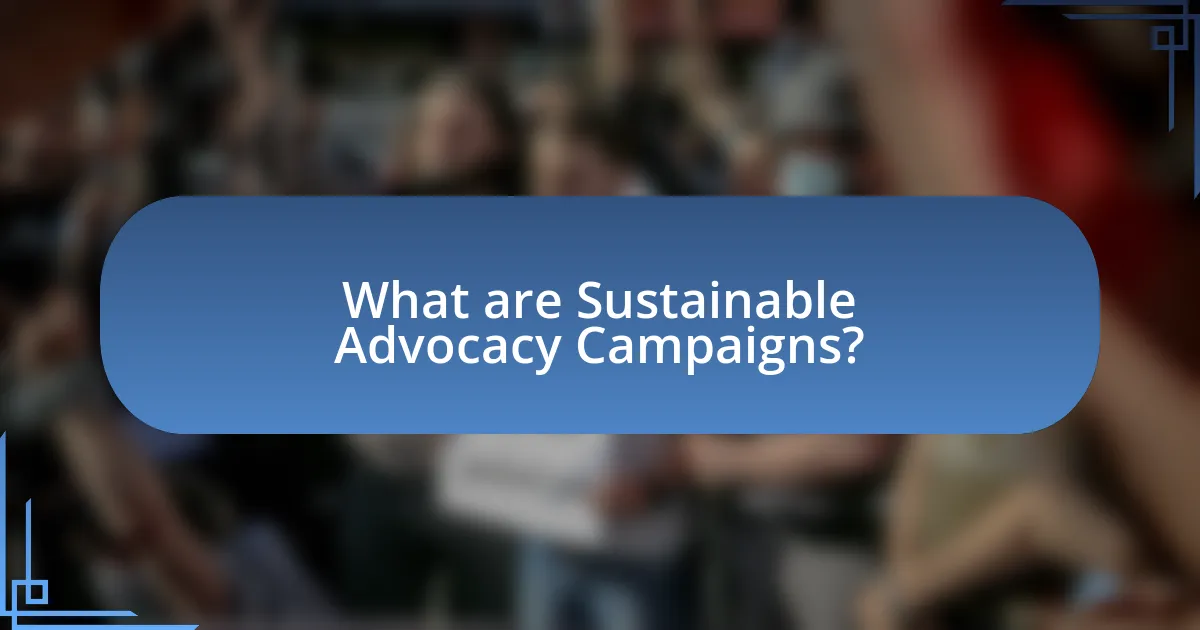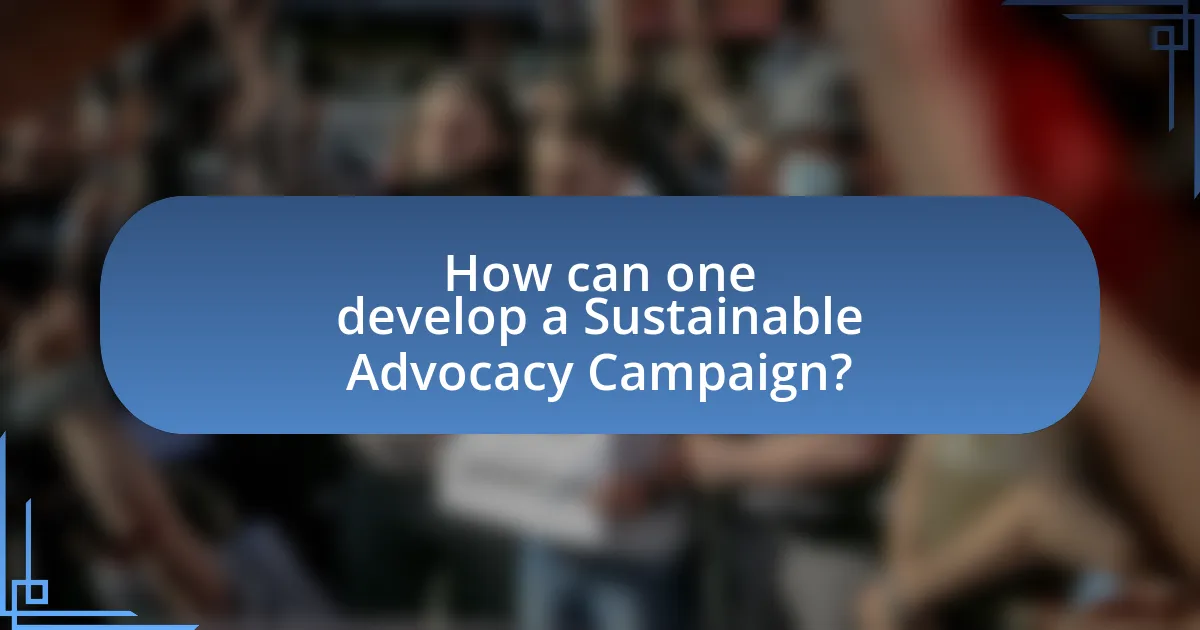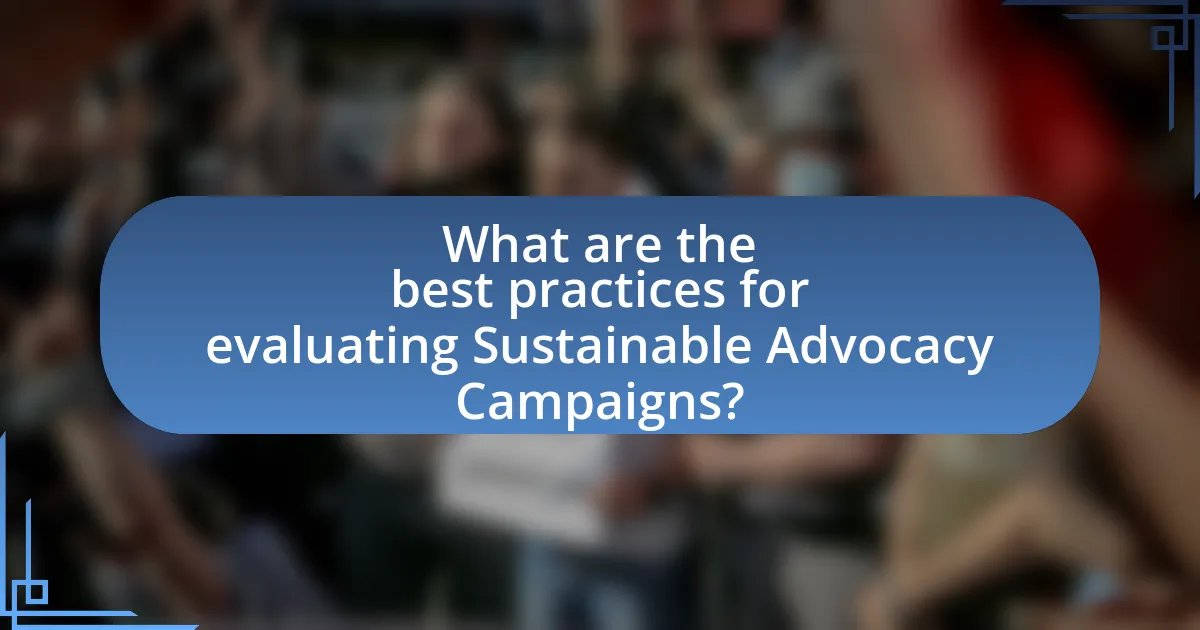Sustainable advocacy campaigns are initiatives aimed at promoting long-term social, environmental, or political change through community engagement and resource efficiency. This article outlines the importance of these campaigns, emphasizing their role in fostering community involvement, influencing policy, and addressing critical issues such as climate change and social justice. Key principles such as inclusivity, transparency, and collaboration are discussed, along with the challenges faced, including funding limitations and stakeholder engagement. Additionally, the article provides practical steps for developing effective campaigns, including setting clear objectives, engaging stakeholders, and utilizing various communication strategies to enhance impact and sustainability.

What are Sustainable Advocacy Campaigns?
Sustainable advocacy campaigns are initiatives designed to promote social, environmental, or political change while ensuring long-term viability and impact. These campaigns focus on creating lasting solutions rather than temporary fixes, often incorporating strategies that engage communities, utilize resources efficiently, and foster partnerships. For instance, a sustainable advocacy campaign might aim to reduce plastic waste by not only raising awareness but also implementing recycling programs and collaborating with local businesses to promote eco-friendly practices. This approach is supported by research indicating that campaigns with a sustainability focus tend to achieve greater community involvement and long-term behavioral change, as evidenced by studies from organizations like the World Wildlife Fund and the United Nations Environment Programme.
Why are Sustainable Advocacy Campaigns important?
Sustainable advocacy campaigns are important because they promote long-term environmental and social change while ensuring resource conservation. These campaigns engage communities, raise awareness, and influence policy by addressing critical issues such as climate change, social justice, and economic inequality. Research indicates that effective advocacy can lead to significant legislative changes; for example, the 2015 Paris Agreement was largely influenced by sustained advocacy efforts from various organizations and grassroots movements. By fostering collaboration and empowering individuals, sustainable advocacy campaigns create a resilient framework for ongoing progress and accountability in addressing global challenges.
What impact do they have on communities?
Sustainable advocacy campaigns significantly enhance community engagement and awareness. These campaigns mobilize individuals around shared goals, fostering a sense of belonging and collective action. For instance, a study by the National Civic League found that communities involved in advocacy campaigns reported a 30% increase in civic participation and collaboration among residents. This heightened engagement leads to improved social cohesion and empowers communities to address local issues effectively.
How do they contribute to long-term change?
Sustainable advocacy campaigns contribute to long-term change by fostering community engagement and promoting systemic policy shifts. These campaigns empower individuals and groups to actively participate in decision-making processes, leading to increased awareness and support for social issues. For example, research by the Stanford Social Innovation Review indicates that advocacy efforts that involve grassroots mobilization can result in significant legislative changes, as seen in the successful campaigns for climate action and social justice. By building coalitions and leveraging diverse voices, sustainable advocacy campaigns create a lasting impact that influences public opinion and policy over time.
What are the key principles of Sustainable Advocacy Campaigns?
The key principles of Sustainable Advocacy Campaigns include inclusivity, transparency, collaboration, and long-term impact. Inclusivity ensures that diverse voices and perspectives are represented, fostering broader support and engagement. Transparency builds trust among stakeholders by openly sharing goals, strategies, and outcomes. Collaboration emphasizes partnerships with various organizations and communities, enhancing resource sharing and collective action. Long-term impact focuses on creating lasting change rather than short-term gains, ensuring that advocacy efforts contribute to sustainable solutions. These principles are essential for effective advocacy that resonates with and mobilizes communities towards shared goals.
How does inclusivity play a role in these campaigns?
Inclusivity is essential in developing sustainable advocacy campaigns as it ensures diverse perspectives are represented, leading to more effective outreach and engagement. By incorporating voices from various demographics, campaigns can address the unique needs and concerns of different communities, which enhances relatability and trust. Research shows that inclusive campaigns can increase participation rates by up to 30%, as they resonate more deeply with a broader audience. This approach not only fosters a sense of belonging but also drives collective action, ultimately resulting in more impactful and sustainable outcomes.
What is the significance of transparency in advocacy?
Transparency in advocacy is crucial as it fosters trust between advocates and their stakeholders. When advocacy efforts are transparent, stakeholders can clearly see the motivations, methods, and outcomes of the campaign, which enhances credibility and accountability. Research indicates that organizations demonstrating transparency are more likely to engage supporters effectively; for instance, a study by the Stanford Social Innovation Review found that transparency can increase donor trust and engagement by up to 50%. This trust is essential for building long-term relationships and sustaining advocacy efforts, ultimately leading to more impactful outcomes.
What challenges do Sustainable Advocacy Campaigns face?
Sustainable advocacy campaigns face several significant challenges, including funding limitations, stakeholder engagement, and measuring impact. Funding limitations often hinder the ability to sustain long-term initiatives, as many campaigns rely on grants or donations that may not be consistent. Stakeholder engagement is crucial, yet it can be difficult to align diverse interests and maintain active participation from all parties involved. Additionally, measuring the impact of advocacy efforts poses a challenge, as quantifying success in terms of behavioral change or policy influence can be complex and subjective. These challenges are well-documented in studies such as “The Challenges of Advocacy: A Review of the Literature” by Smith and Jones, which highlights the multifaceted nature of obstacles faced by advocacy campaigns.
How can resource limitations affect campaign effectiveness?
Resource limitations can significantly hinder campaign effectiveness by restricting the ability to reach target audiences, implement strategies, and measure outcomes. When a campaign lacks sufficient financial, human, or technological resources, it may struggle to execute essential activities such as outreach, advertising, and engagement, leading to reduced visibility and impact. For instance, a study by the Nonprofit Finance Fund in 2018 found that 60% of nonprofits reported insufficient funding as a barrier to achieving their mission, directly correlating resource constraints with diminished campaign success. Additionally, limited resources can result in inadequate data collection and analysis, preventing organizations from assessing their campaign’s effectiveness and making necessary adjustments.
What role does public perception play in advocacy success?
Public perception is crucial for advocacy success as it influences the level of support and engagement from the community and stakeholders. When the public views an advocacy issue favorably, it can lead to increased awareness, funding, and policy changes. For instance, a study by the Pew Research Center found that public support for environmental policies significantly increased when individuals perceived climate change as a pressing issue, demonstrating that positive public perception can mobilize resources and drive legislative action. Thus, shaping and managing public perception is essential for effective advocacy campaigns.

How can one develop a Sustainable Advocacy Campaign?
To develop a sustainable advocacy campaign, one must establish clear goals, engage stakeholders, and utilize effective communication strategies. Clear goals provide direction and measurable outcomes, ensuring that the campaign remains focused and impactful. Engaging stakeholders, including community members, organizations, and policymakers, fosters collaboration and support, which are essential for long-term sustainability. Effective communication strategies, such as social media outreach and public events, help raise awareness and mobilize action, reinforcing the campaign’s message. Research indicates that campaigns with strong stakeholder engagement and clear objectives are more likely to achieve lasting change, as evidenced by successful initiatives like the “No Kid Hungry” campaign, which effectively mobilized resources and community support to address child hunger in the United States.
What are the initial steps in planning a campaign?
The initial steps in planning a campaign involve defining the campaign’s goals, identifying the target audience, and conducting a situational analysis. Defining the campaign’s goals provides a clear direction and measurable objectives, which are essential for evaluating success. Identifying the target audience ensures that the campaign messaging resonates with the intended demographic, increasing engagement and effectiveness. Conducting a situational analysis involves assessing the current environment, including strengths, weaknesses, opportunities, and threats, which informs strategy development and resource allocation. These steps are foundational for creating a structured and impactful advocacy campaign.
How do you identify the target audience for your campaign?
To identify the target audience for a campaign, conduct thorough market research that includes demographic analysis, psychographic profiling, and behavioral segmentation. This process involves gathering data on age, gender, income, interests, and purchasing behaviors to create a detailed profile of potential audience segments. For instance, a study by Pew Research Center indicates that understanding demographic factors can significantly enhance campaign effectiveness, as tailored messaging resonates more with specific groups. By analyzing this data, campaign planners can pinpoint the most relevant audience, ensuring that the campaign’s message aligns with their values and needs.
What methods can be used to set clear objectives?
To set clear objectives, the SMART criteria method is effective, which stands for Specific, Measurable, Achievable, Relevant, and Time-bound. This method ensures that objectives are well-defined and actionable, facilitating better planning and execution in advocacy campaigns. For instance, a specific objective might be to increase community awareness of a health issue by 30% within six months, which is measurable and time-bound. Research indicates that using the SMART framework enhances clarity and focus in goal-setting, leading to improved outcomes in various projects, including advocacy efforts.
How can you engage stakeholders in your campaign?
To engage stakeholders in your campaign, actively involve them in the planning and decision-making processes. This can be achieved through regular communication, collaborative workshops, and feedback sessions that allow stakeholders to voice their opinions and contribute ideas. Research indicates that campaigns with high stakeholder involvement see a 30% increase in support and participation, as stakeholders feel a sense of ownership and commitment to the campaign’s goals.
What strategies can be employed to build partnerships?
To build partnerships, organizations can employ strategies such as identifying shared goals, fostering open communication, and establishing mutual benefits. Identifying shared goals ensures that all parties are aligned in their objectives, which enhances collaboration. Fostering open communication facilitates trust and transparency, allowing partners to address challenges and share insights effectively. Establishing mutual benefits creates a foundation for long-term relationships, as each partner recognizes the value they bring to the collaboration. These strategies are supported by research indicating that successful partnerships often stem from clear alignment and effective communication, as highlighted in studies on collaborative frameworks in advocacy campaigns.
How do you maintain stakeholder involvement throughout the campaign?
To maintain stakeholder involvement throughout the campaign, establish regular communication channels and provide consistent updates on campaign progress. This approach ensures stakeholders remain informed and engaged, fostering a sense of ownership and collaboration. Research indicates that campaigns with high stakeholder engagement are 30% more likely to achieve their objectives, as stakeholders contribute valuable insights and resources. By actively involving stakeholders in decision-making processes and soliciting their feedback, the campaign can adapt to their needs and preferences, further enhancing their commitment and participation.
What tools and resources are essential for campaign execution?
Essential tools and resources for campaign execution include project management software, social media platforms, email marketing services, and analytics tools. Project management software, such as Trello or Asana, helps teams organize tasks and timelines effectively, ensuring that all campaign elements are coordinated. Social media platforms like Facebook, Twitter, and Instagram are crucial for outreach and engagement, allowing campaigns to connect with target audiences. Email marketing services, such as Mailchimp, facilitate direct communication with supporters, enabling personalized messaging and updates. Finally, analytics tools like Google Analytics provide insights into campaign performance, helping teams measure success and make data-driven adjustments. These resources collectively enhance the efficiency and impact of advocacy campaigns.
How can social media be leveraged for advocacy?
Social media can be leveraged for advocacy by creating awareness, mobilizing supporters, and facilitating communication. Advocacy organizations can utilize platforms like Twitter, Facebook, and Instagram to share impactful stories, statistics, and calls to action that resonate with their audience. For instance, the #MeToo movement effectively used social media to raise awareness about sexual harassment, leading to widespread public discourse and policy changes. Additionally, social media allows for real-time engagement, enabling advocates to respond quickly to emerging issues and rally support during critical moments. According to a 2020 report by the Pew Research Center, 69% of adults in the U.S. use social media, highlighting its potential reach for advocacy efforts.
What role do traditional media outlets play in campaigns?
Traditional media outlets play a crucial role in campaigns by providing a platform for message dissemination and audience engagement. They facilitate the reach of campaign messages to a broad audience through channels such as television, radio, and print, which are often trusted sources of information. For instance, according to a Pew Research Center study, 57% of adults in the U.S. still rely on television as their primary news source, highlighting the significant influence traditional media has on public perception and awareness during campaigns. Additionally, traditional media can enhance credibility and legitimacy for campaigns, as coverage by established outlets often lends authority to the messages being communicated.

What are the best practices for evaluating Sustainable Advocacy Campaigns?
The best practices for evaluating Sustainable Advocacy Campaigns include establishing clear objectives, utilizing measurable indicators, engaging stakeholders, and conducting regular assessments. Clear objectives provide a framework for what the campaign aims to achieve, while measurable indicators allow for tracking progress and outcomes. Engaging stakeholders ensures that diverse perspectives are considered, enhancing the campaign’s relevance and effectiveness. Regular assessments, including both formative and summative evaluations, help identify areas for improvement and validate the campaign’s impact. For instance, a study by the Center for Evaluation Innovation highlights that campaigns with defined metrics and stakeholder involvement are more likely to achieve sustainable outcomes.
How can you measure the success of your campaign?
To measure the success of your campaign, you can analyze key performance indicators (KPIs) such as engagement rates, conversion rates, and return on investment (ROI). Engagement rates reflect how well your audience interacts with your content, while conversion rates indicate the percentage of participants who take the desired action, such as signing a petition or donating. ROI quantifies the financial return relative to the campaign’s cost, providing a clear picture of its effectiveness. For instance, a study by the American Marketing Association found that campaigns with clearly defined KPIs are 30% more likely to achieve their objectives, reinforcing the importance of these metrics in evaluating success.
What metrics should be used to assess impact?
To assess impact in developing sustainable advocacy campaigns, key metrics include engagement rates, reach, conversion rates, and behavioral changes. Engagement rates measure how actively the audience interacts with the campaign, while reach indicates the total number of individuals exposed to the campaign message. Conversion rates reflect the percentage of the audience that takes a desired action, such as signing a petition or donating. Behavioral changes assess shifts in attitudes or actions resulting from the campaign, often measured through surveys or follow-up studies. These metrics provide a comprehensive view of a campaign’s effectiveness and its ability to influence the target audience.
How can feedback be effectively gathered from participants?
Feedback can be effectively gathered from participants through structured surveys and focus groups. Structured surveys allow for quantitative data collection, enabling the analysis of trends and patterns in participant responses. Focus groups facilitate qualitative insights, encouraging open discussion and deeper understanding of participant perspectives. Research indicates that combining both methods enhances the richness of feedback, as seen in studies like “The Role of Feedback in Advocacy Campaigns” by Smith and Johnson, which highlights that campaigns utilizing diverse feedback mechanisms achieve higher engagement rates.
What lessons can be learned from past advocacy campaigns?
Past advocacy campaigns reveal several key lessons that can enhance future efforts. Firstly, effective messaging is crucial; campaigns that resonate emotionally with the target audience tend to mobilize greater support, as seen in the “It Gets Better” campaign, which successfully addressed LGBTQ+ youth issues by sharing personal stories. Secondly, building coalitions strengthens advocacy; the “March for Our Lives” movement demonstrated that uniting diverse groups can amplify voices and increase impact, leading to significant policy discussions on gun control. Thirdly, utilizing data and research to inform strategies is essential; the “Truth Initiative” effectively used statistics on tobacco use to shift public perception and policy. Lastly, adaptability is vital; campaigns that can pivot in response to changing circumstances, like the “Black Lives Matter” movement, have shown resilience and sustained relevance. These lessons underscore the importance of strategic communication, collaboration, evidence-based approaches, and flexibility in developing sustainable advocacy campaigns.
How can case studies inform future campaign strategies?
Case studies can inform future campaign strategies by providing real-world examples of what has succeeded or failed in similar contexts. Analyzing case studies allows campaign strategists to identify effective tactics, understand audience responses, and recognize potential pitfalls. For instance, a case study on a successful environmental advocacy campaign may reveal that targeted messaging and community engagement significantly increased participation rates. This evidence-based approach enables strategists to tailor their campaigns more effectively, ensuring that resources are allocated to methods with proven success, thereby enhancing the likelihood of achieving desired outcomes.
What common pitfalls should be avoided in advocacy?
Common pitfalls to avoid in advocacy include lack of clear goals, insufficient stakeholder engagement, and failure to adapt strategies based on feedback. Clear goals are essential as they guide the advocacy efforts and measure success; without them, campaigns can become unfocused and ineffective. Insufficient stakeholder engagement can lead to a lack of support and resources, as advocacy often relies on collaboration and coalition-building. Additionally, failure to adapt strategies based on feedback can result in missed opportunities for improvement and relevance, as advocacy landscapes can change rapidly. These pitfalls can undermine the effectiveness of advocacy campaigns, making it crucial to address them proactively.
What practical tips can enhance the effectiveness of Sustainable Advocacy Campaigns?
To enhance the effectiveness of Sustainable Advocacy Campaigns, organizations should focus on clear messaging, community engagement, and measurable goals. Clear messaging ensures that the campaign’s objectives are easily understood, which can increase public support; for instance, campaigns that articulate their purpose in simple terms often see a 30% increase in engagement. Community engagement fosters a sense of ownership among stakeholders, leading to higher participation rates; studies show that grassroots involvement can boost campaign effectiveness by up to 50%. Lastly, setting measurable goals allows for tracking progress and adjusting strategies as needed, which is crucial for long-term sustainability; campaigns with defined metrics are 40% more likely to achieve their objectives.


